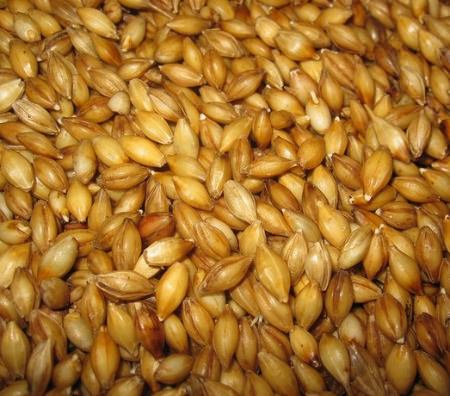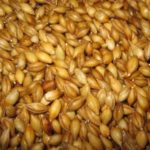 The video lesson plus written recipe features how to make sprouted grains at home and thus make your homemade sprouted flour for all your baking needs.
The video lesson plus written recipe features how to make sprouted grains at home and thus make your homemade sprouted flour for all your baking needs.
China is credited with developing the method for germinating seeds many centuries ago and on long ocean voyages, Chinese sailors used sprouted mung beans as a source of vitamin C for preventing scurvy.
Vitamin C is produced in significant quantities when you sprout seeds. It is absent from unsprouted seeds! Many other nutrients are increased substantially from sprouting grains, as I go over in the videos.
Sprouting Grain
Sprouted flour made from freshly ground sprouted grain is one of the 3 ways traditional societies used to prepare their grains before eating.
This careful preparation of wheat and other grains is necessary in order to break down the antinutrients, toxins, and difficult to digest proteins (i.e., gluten) so as to optimize digestibility and to allow maximum absorption of nutrients.
Unfortunately, this careful preparation method has been lost with our modern cooking methods which focus on speed and convenience rather than nutrient density and digestibility!
Equipment Needed to Sprout Grain
The first item you need to sprout is a half gallon size glass container with a screen lid (like this one). Many health food stores sell sprouting jars, but you can easily make one yourself at home using a glass jar and a clean pair of pantyhose cut to fit the lid of the jar and fastened with a rubber band.
Once you have your jar ready, fill it no more than halfway with the grain you wish to sprout. I use organic spelt or organic soft white wheat that I obtain from my local grain co-op. For other ideas, visit my Resources page.

Sprouting Grains Recipe
How to sprout grains at home easily and cost effectively that will improve the nutrient value of your baked goods. Recipe can be used to sprout any types of grain.
Instructions
-
Place the wheat berries in the sprouting jar and affix the screen lid.
-
Rinse and drain the wheat grains several times with filtered water until the berries are completely wet.
-
Fill the jar until almost full with water and let the berries soak overnight on the kitchen counter.
-
The next morning, tip the jar and drain out the water using the screen lid to prevent the berries from spilling out. Rinse the wheat one more time and then invert the jar and let it sit at an angle to facilitate draining and allowing the circulation of air.
-
Rinse the wheat one more time and then invert the jar and let it sit at an angle to facilitate draining and allowing the circulation of air. I use my grain grinder as a support for the jar so that the draining occurs right over the kitchen sink.
-
Every few hours, rinse the wheat again and reset the jar in the draining position.
-
In anywhere from a few hours to a few days (depending on the time of year and warmth/humidity in your home), small white buds will appear on the ends of the wheat kernels. See the picture for what it should look like.
-
When this occurs, pour the sprouted wheat kernels into baking pans and place in a dehydrator or a warm oven (150 F/ 66 C) for about 24 hours until fully dried.
-
Store the sprouted grains in an airtight container in the refrigerator, or grind immediately and then freeze the sprouted flour. Use sprouted flour just like you would use regular flour in your favorite baking recipes.
Sprouted Grain Recipes to Try
Baked goods made with sprouted flour are much more digestible/filling. As a result, you will find that you eat much less of the same item when you use sprouted flour!
Try making this sprouted flour pizza crust or these sprouted flour brownies with your sprouted flour!
Where to Find Organic or Already Sprouted Grain
If after watching these two short videos on sprouted grains below you have interest in trying your hand at making your own sprouted flour for baking, please visit my Resources page for where to buy quality sprouted grains for grinding into fresh sprouted flour (my favorite is einkorn … completely unhybridized wheat) or to locate suppliers of organic grain for making sprouted grains at home yourself.
How to Make Sprouted Grains (Videos)
The two videos below demonstrate how to sprout grains. The first video shows the soaking process and the second the sprouting process.
Sarah, The Healthy Home Economist
More Information
Teff Grains (sprouted or not) Deliver Big on Nutrition
Amaranth: Superfood of the Aztecs








I found that 1 cup of wheat berries produces about 1 1/2 C flour – depending on how much you shake it down. Also, my regular bread recipe did not work the first time I tried it (on a rainy day) but the next time I was more careful to add the final flour slowly, so as not to let it get dry, and it turned out perfect.
Vickie
Hello Sarah, Thank you for providing this video. I do have a question, which I hope you will be able to answer due to your experience with sprouting and grinding grains: how many cups of flour does one cup of grain (pre-sprouted) provide?
Cristina
Thanks for answering so quickly. I did have another question. Can I use my normal bread recipe (from the urban homemaker) or are there specific recipes designed for sprouted wheat flour?
Vickie
My grinder is pretty strict as well and it grinds the sprouted berries just fine .. just make sure they are fully dried in a warm oven first.
My K-tech Kitchen Mill grain grinder has strict instructions on what kind of things can be ground. Are sprouted wheat berries able to be ground in all kinds of wheat grinders?
Vickie Halteman
Can the sprouted grains be dried in an oven at 170 degrees? That’s the lowest temperature on my oven. Thank you!
170 F is too high. Most ovens have a setting (look in the user manual) that you can adjust the temperature down to 150 as needed. Other ovens have a “warm” setting that works too. Otherwise, you will need a dehydrator.
i have some wheat that is several years old (15) that will not sprout and even just ground it makes bricks instead of bread. Is there any use for it?
I'm thinking perhaps fermenting.
Lucina
Hi Leah, Frontier and Wheat Montana both have grain co-ops in this area.
You're actually my local chapter leader and I was wondering where you get your grains from.
Yes, you understood that right, Dorsey. In my opinion, sprouting grains creates the most digestible form for consuming grains .. better than soaking or sour leavening. Whether the difference is significant or not probably depends on the person and the state of their gut health. Someone with severe gut imbalance may find it to be significantly more digestible, while someone who has good gut health may not notice much difference at all.
Thanks once again. Do I understand correctly that besides getting more of the C and B vitamins, that sprouting will make the grain more digestible than the soaking method? Is the difference in digestibility significant or mildly different?
I really do enjoy these video Thursdays! Thanks for taking the time as pictures are worth a thousand words. 🙂